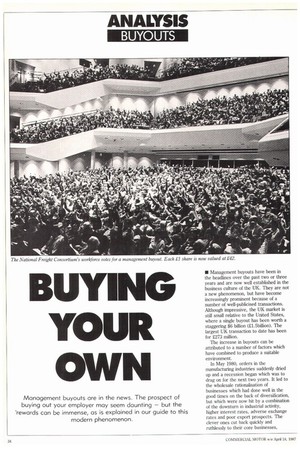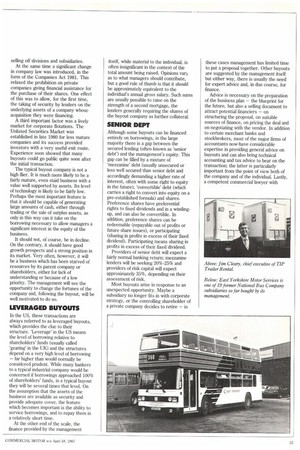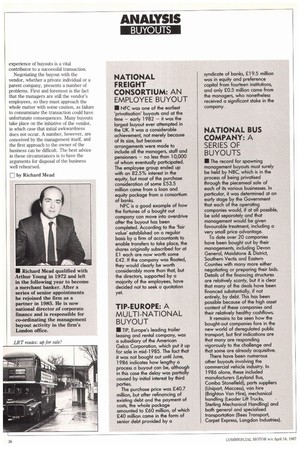BUYING YOUR OWN
Page 36

Page 37

Page 38

If you've noticed an error in this article please click here to report it so we can fix it.
Management buyouts are in the news. The prospect of buying out your employer may seem daunting — but the 'rewards can be immense, as is explained in our guide to this modern phenomenon. • Management buyouts have been in the headlines over the past two or three years and are now well established in the business culture of the UK. They are not a new phenomenon, but have become increasingly prominent because of a number of well-publicised transactions. Although impressive, the UK market is still small relative to the United States, where a single buyout has been worth a staggering $6 billion (21.5billion). The largest UK transaction to date has been for 2273 million.
The increase in buyouts can be attributed to a number of factors which have combined to produce a suitable environment.
In May 1980, orders in the manufacturing industries suddenly dried up and a recession began which was to drag on for the next two years. It led to the wholesale rationalisation of businesses which had done well in the good times on the back of diversification, but which were now hit by a combination of the downturn in industrial activity, higher interest rates, adverse exchange rates and poor export prospects. The clever ones cut back quickly and ruthlessly to their core businesses, selling off divisions and subsidiaries.
At the same time a significant change in company law was introduced, in the form of the Companies Act 1981. This relaxed the prohibition on private companies giving financial assistance for the purchase of their shares. One effect of this was to allow, for the first time, the taking of security by lenders on the underlying assets of a company whose acquisition they were financing.
A third important factor was a lively market for corporate flotations. The Unlisted Securities Market was established in late 1980 for less mature companies and its success provided investors with a very useful exit route. Experience soon showed that many buyouts could go public quite soon after the initial transaction.
The typical buyout company is not a high flier. It is much more likely to be a fairly mature, even staid business with a value well supported by assets. Its level of technology is likely to be fairly low. Perhaps the most important feature is that it should be capable of generating large amounts of cash, either through trading or the sale of surplus assets, as only in this way can it take on the borrowing necessary to allow managers a significant interest in the equity of the business.
It should not, of course, be in decline. On the contrary, it should have good growth prospects and a strong position in its market. Very often, however, it will be a business which has been starved of resources by its parent company or shareholders, either for lack of understanding or because of a low priority. The management will see the opportunity to change the fortunes of the company and, following the buyout, will be well motivated to do so.
LEVERAGED BUYOUTS
In the US, these transactions are always referred to as leveraged buyouts, which provides the clue to their
structure. `Leverage' in the US means the level of borrowing relative to shareholders' funds (usually called 'gearing' in the UK) and the structures depend on a very high level of borrowing — far higher than would normally be considered prudent. While many bankers to a typical industrial company would be concerned if borrowings approached 100% of shareholders funds, in a typical buyout they will be several times that level. On the assumption that the assets of the business are available as security and provide adequate cover, the feature which becomes important is the ability to service borrowings, and to repay them in a relatively short time.
At the other end of the scale, the finance provided by the management itself, while material to the individual, is often insignificant in the context of the total amount being raised. Opinions vary as to what managers should contribute, but a good rule of thumb is that it should be approximately equivalent to the individual's annual gross salary. Such sums are usually possible to raise on the strength of a second mortgage, the lenders generally requiring the shares of the buyout company as further collateral.
SENIOR DEPT
Although some buyouts can be financed entirely on borrowings, in the large majority there is a gap between the secured lending (often known as `senior debt') and the management's equity. This gap can be filled by a mixture of 'mezzanine' debt (usually unsecured or less well secured than senior debt and accordingly demanding a higher rate of interest, often with some right to equity in the future), 'convertible' debt (which carries a right to convert into equity on a pre-established formula) and shares. Preference shares have preferential rights to fixed dividends and in a windingup, and can also be convertible. In addition, preference shares can be redeemable (repayable out of profits or future share issues), or participating (sharing in profits in excess of their fixed dividend). Participating means sharing in profits in excess of their fixed dividend.
Providers of senior debt will expect a fairly normal banking return; mezzanine lenders will be seeking 20%-25% and providers of risk capital will expect approximately 35%, depending on their assessment of risk.
Most buyouts arise in response to an unexpected opportunity. Maybe a subsidiary no longer fits in with corporate strategy, or the controlling shareholder of a private company decides to retire — in these cases management has limited time to put a proposal together. Other buyouts are suggested by the management itself but either way, there is usually the need for expert advice and, in due course, for finance.
Advice is necessary on the preparation of the business plan — the blueprint for the future, but also a selling document to attract potential financiers — on structuring the proposal, on suitable sources of finance, on pricing the deal and on negotiating with the vendor. In addition to certain merchant banks and stockbrokers, most of the major firms of accountants now-have considerable expertise in providing general advice on buyouts and can also bring technical accounting and tax advice to bear on the transaction; the latter is particularly important from the point of view both of the company and of the individual. Lastly, a competent commercial lawyer with experience of buyouts is a vital contributor to a successful transaction.
Negotiating the buyout with the vendor, whether a private individual or a parent company, presents a number of problems. First and foremost is the fact that the managers are still the vendor's employees, so they must approach the whole matter with some caution, as failure to consummate the transaction could have unfortunate consequences. Many buyouts take place on the initiative of the vendor, in which case that initial awkwardness does not occur. A number, however, are conceived by the management itself, and the first approach to the owner of the business can be difficult. The best advice in these circumstances is to have the arguments for disposal of the business well rehearsed.
111 by Richard Mead




















































































